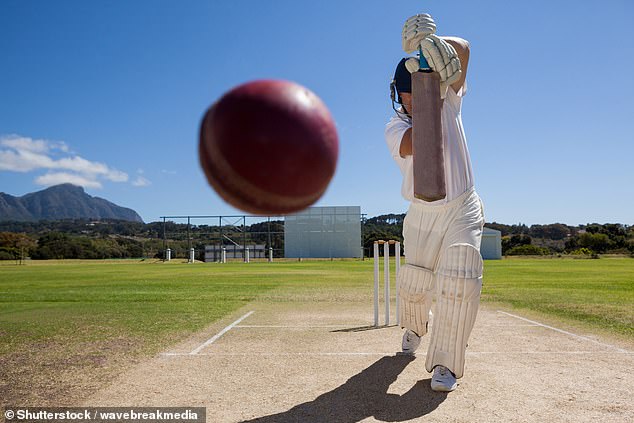[ad_1]
Korean experts have pinpointed how to make the best sport helmet for protecting athletes’ brains.
Head injuries are a common risk in many sports, from cricket, rugby, football and roller derby to name a few.
Some studies suggest up to 40 per cent of athletes will suffer an injury over a year’s worth of training and competing.
In sports like cricket the risk can rise to 70 per cent, with just over one in 10 of these injuries to critical areas like the head, neck and face mainly due to a hard ball launched at high speeds from bowler to batsman
The consequences of such injuries can be devastating.
Aussie cricketer Phillip Hughes, 25, was famously killed in 2014 after a devastating head injury delivered by a bouncer bowled by Sean Abbott.
He was later confirmed to have died from a vertebral artery dissection, a tear in one of the arteries in the neck that feeds the brainstem oxygen rich blood. Such an injury carries the risk of causing a stroke.
Now, a team of researchers have come up with a way to assess the best helmet material to reduce serious head injuries.

Korean experts have pinpointed how to make the best sport helmet for protecting athletes’ brains
Scientists from Chongqing Jiaotong University alongside Chongqing No. 7 Middle School, analysed the performance of three different helmet materials.
These were a strong plastic called Acrylonitrile Butadiene Styrene (ABS), fibreglass alloys, and aluminium composites.
Using computer simulations, the team made digital copies of helmets made from each material.
These digital helmets were then put through a variety of computerised impact scenarios based on cricket with the team analysing how well they protected a simulated human head and brain within.
They found that for training and at a recreational level an ABS helmet provided sufficient protection.
However, at an elite level—where balls travel at a faster, and therefore more dangerous, speed—fibreglass or aluminium alloys performed better.
They added while either of these had its advantages, they noted that fibreglass being more brittle than aluminium gave it an advantage as it distributed the stress of an impact across its entire surface, lowering the risk of a traumatic injury.
Author of the study, which was published in the journal AIP Advances, Tao Wang said while the results are interesting they are not universal to every sport which each have their unique stresses.

Phillip Hughes was hit in the head by a short ball delivered by fast bowler Abbott on November 25, 2014. He died two days later in hospital
‘Each sport should be checked individually, because loading conditions are different in different sports,’ he said.
Government data suggests there are about 6,500 sports related concussion admissions to hospitals in England per year.
The issue of head injuries in sport has come under increasing focus in recent years due to fears that repeated blows could increase the risk of dementia.
A 2023 study commissioned by the Football Association and Professional Footballers’ Association, found professional footballers have triple the likelihood of being diagnosed with dementia than the general population.
However, subsequent studies have found this isn’t likely to be a risk for amateur players.
In fact, playing sport was found to be protective against dementia most likely due to regularly doing exercise a known factor that protects against the memory robbing disorder.
[ad_2]
This article was originally published by a www.dailymail.co.uk . Read the Original article here. .

